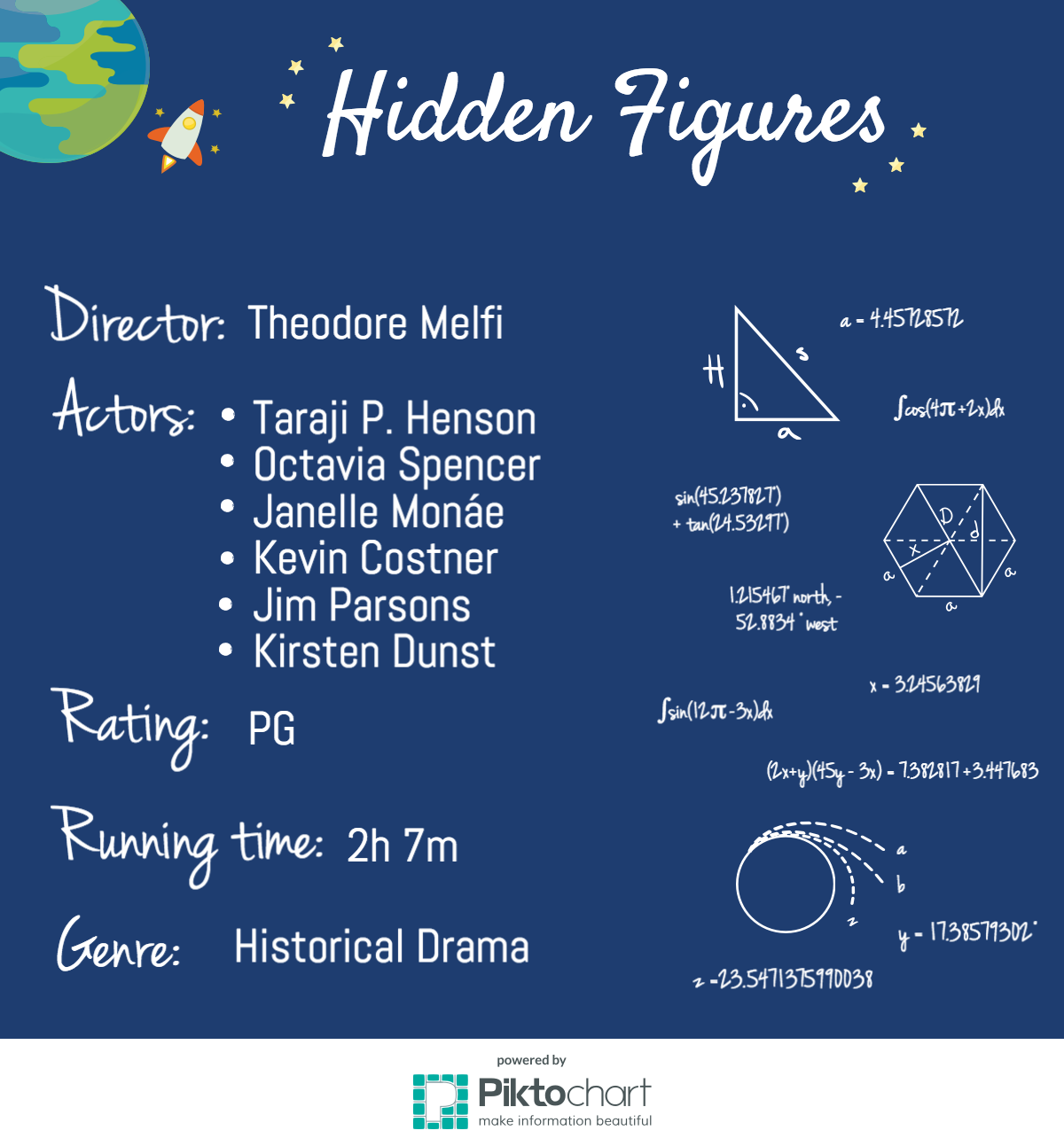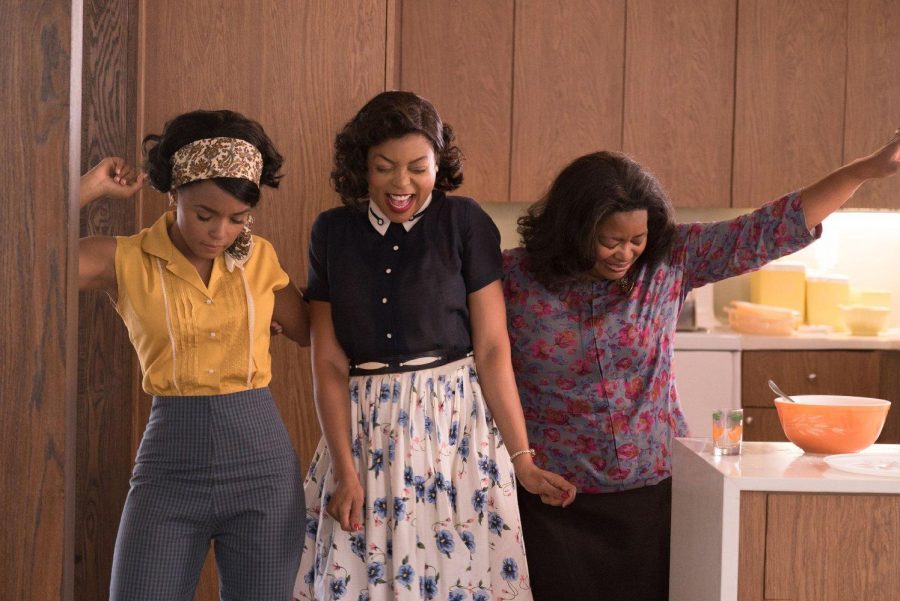ight months ago, Katherine Johnson sat inside NASA’s Langley Research Center in Virginia to attend a naming ceremony for the Katherine G. Johnson Computational Research Facility. Fifty-four years earlier, Johnson sat at her desk in the same building, calculating the path that astronaut John Glenn would take to orbit the Earth, allowing him to become the first American to do so. And while Johnson’s calculations were integral to the success of the mission, her story, as well as those of the many other pioneering African American women at NASA, had gone seemingly unacknowledged by the vast American public — that is — until the release of the historical drama, Hidden Figures.

The movie explores the interconnected stories of Katherine Johnson, Mary Jackson and Dorothy Vaughan, three African American women who were essential to many of NASA’s historic space missions, including the Friendship 7. The movie manages to portray many different aspects of the three women’s careers and lives on the big screen in a way that most science biopics do not. The film goes beyond its predictable plot line by not only speaking of the women’s technical achievements, but also of their lives and relationships. What would have otherwise been a movie about NASA’s computational struggles instead became a complex story of love, motherhood and friendship.
However, the complexity of telling these three accomplished women’s stories within the span of two hours becomes both an immense accomplishment and a point of concern. As with most historical biopics, timelines and events are stretched and shifted to allow for smoother transitions — an understandable flaw. But the movie borrowed another concerning feature from biopics: a conventional plot line. The screenplay seemed almost hesitant to take risks in the telling of such an audacious story. It was, for the most part, predictable. Nevertheless, the fearless nature of the story and an incredible cast allows for an immersively detailed portrayal of the women’s stories, effectively making up for any conformity. It’s the women’s stories that take the main stage, and are fascinating enough without the addition of a flamboyant plot line or computer graphics.

When the story begins, Katherine, Mary and Dorothy, along with about 30 other African American women, are limited to working strictly as “human computers”— employees tasked with doing complex calculations by hand for NASA at West Area Computers, a facility segregated due to Jim Crow laws. Despite this, the three women soon make their way up the NASA hierarchy as a result of to their skill, persistence and hard work.
The United States’ determination to lead the space race also compels them to take all the help they could get, including that of Katherine, whose expertise in analytical geometry has NASA defying segregation on campus, at least temporarily. She is consequently assigned to Langley’s Flight Research Division, in charge of calculating the launch and landing of the Friendship 7. While she is excited and proud to be there, she struggles to overcome racism as the only African American on the team, a feeling that actress Taraji P. Henson portrays naturally. Henson is the perfect combination of shy and passionate, injecting her own quirks and mannerisms into Katherine’s persevering character. Katherine’s work to overcome race and gender bias in her workplace makes way for Mary and Dorothy’s own advancement through NASA’s ranks.
The three women seem to constantly both outwork and outsmart their peers, taking advantage of every scarce opportunity in their sexist and racist workplace. Mary, who possesses the talent and intelligence needed to become an engineer, is hindered by legal structures in place that forbid her from taking the classes needs to apply for the position. Her frustration is summed up in her line, “Every time we get a chance to get ahead they move the finish line. Every time.” With gradual support from her family, friends and colleagues, she fights the discriminatory system with a steadfast determination that allows her to become NASA’s first female African American engineer. Janelle Monáe’s spirited performance as Mary brings excitement and laughter to the film with her confident personality and sassy remarks. One moment she has the audience in hysterics and the next she has them open-mouthed, in awe at her moving monologue.

By making their way up the system through hard work, Mary and the rest of the women combat racism in a way that stands in stark contrast to that of other characters in the movie. While the others, such as Mary’s husband, believe that equality for African Americans is better made possible by working outside of the law — by protesting and practicing disobedience — the women fight racism through their own resistance; by commanding respect by working for and earning it, an idea that Dorothy, played with a quiet strength by Octavia Spencer, constantly believes in. When new technology such as the introduction of the IBM (International Business Machines) machine threatens to replace her and the rest of the human computers’ jobs, Dorothy promptly takes action. She learns the computer language FORTRAN and the operation of the IBM before those in charge, despite the legal restrictions preventing her from doing so. As a result of her hard work, she becomes the first African American manager at NASA and later, a pioneer of computer science.
However, the most heartwarming aspect of the film lies beyond the grandeur of the ladies’ accomplishments and the flight of the Friendship 7. Instead, it was the triad’s relationship with each other— constant support and encouragement from all sides — that was the most enjoyable to watch. The film takes the viewer deep inside the homes and churches of the characters, allowing relationships and families to take the spotlight— whether it be related to the space race or not. It was a refreshing take on the lives of hardworking scientists; to see their lives and relationships form beyond the scope of their work.

The movie is much more than a recollection of the lives of three monumental NASA mathematicians; it is also the story of three African American women who built their identities, formed relationships and paved a path for future generations of engineers and scientists, all in the face of the racism and sexism of the time.
The film’s exploration of the fluidity and pervasiveness of racism and sexism through its different characters is more realistic and, as a result, more troubling for modern audiences. Unlike its counterparts, the film does not draw a clear line separating characters into racists and non-racists, but rather portrays racism as it exists: invisible to those who behold it. The movie portrays prejudice as it is; a constant presence so ingrained in the collective society that most don’t even recognize it within themselves. Mrs. Michael (Kirsten Dunst), Dorothy’s manager, is the perfect example of this, constantly showing judgement towards African Americans, but blissfully unaware of it. Her obliviousness is clear when she says, “Despite what you may think, I have nothing against y’all.” Dorothy’s reply is one of the film’s most significant lines: “I know you probably think that.”
Hidden Figures transcends its conventional plot line through the depth and power of the historically and culturally significant stories told. Aided by exceptional performances from the leading ladies, the already memorable film becomes remarkable. The timeliness of the message and the importance of its release make the movie more than just immense box office success, but a must-see.










